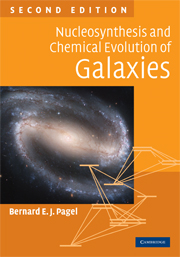Book contents
- Frontmatter
- Contents
- List of abbreviations
- Preface to the first edition
- Preface to the second edition
- 1 Introduction and overview
- 2 Thermonuclear reactions
- 3 Cosmic abundances of elements and isotopes
- 4 Cosmological nucleosynthesis and abundances of light elements
- 5 Outline of stellar structure and evolution
- 6 Neutron capture processes
- 7 Galactic chemical evolution: basic concepts and issues
- 8 Some specific GCE models and related observational data
- 9 Origin and evolution of light elements
- 10 Radioactive cosmochronology
- 11 Chemical evolution in other sorts of galaxies
- 12 Cosmic chemical evolution and diffuse background radiation
- Appendix 1 Some historical landmarks
- Appendix 2 Some physical and astronomical constants
- Appendix 3 Time-dependent perturbation theory and transition probabilities
- Appendix 4 Polytropic stellar models
- Appendix 5 Dissipation and abundance gradients
- Appendix 6 Hints for problems
- References
- Index
9 - Origin and evolution of light elements
Published online by Cambridge University Press: 05 June 2012
- Frontmatter
- Contents
- List of abbreviations
- Preface to the first edition
- Preface to the second edition
- 1 Introduction and overview
- 2 Thermonuclear reactions
- 3 Cosmic abundances of elements and isotopes
- 4 Cosmological nucleosynthesis and abundances of light elements
- 5 Outline of stellar structure and evolution
- 6 Neutron capture processes
- 7 Galactic chemical evolution: basic concepts and issues
- 8 Some specific GCE models and related observational data
- 9 Origin and evolution of light elements
- 10 Radioactive cosmochronology
- 11 Chemical evolution in other sorts of galaxies
- 12 Cosmic chemical evolution and diffuse background radiation
- Appendix 1 Some historical landmarks
- Appendix 2 Some physical and astronomical constants
- Appendix 3 Time-dependent perturbation theory and transition probabilities
- Appendix 4 Polytropic stellar models
- Appendix 5 Dissipation and abundance gradients
- Appendix 6 Hints for problems
- References
- Index
Summary
… how turn ye again to the weak and beggarly elements, whereunto ye desire again to be in bondage?
Galatians 4:9Introduction
The light elements (D to B, apart from 4He) have such fragile nuclei (see Table 9.1) that they tend to be destroyed, rather than created, in thermonuclear burning, although certain special processes can lead to stellar production of 3He, 7Li and 11B.
B2FH accordingly postulated for their creation an ‘x’-process involving spallation by fast particles at high energy, but low temperature and density. They considered stellar flares and supernova shells as possible sites, while also envisaging the possibility of 7Li creation in H-free helium zones in stars. Since then, it has been accepted that all D, some 3He and some 7Li come from the Big Bang (see Chapter 4), where rapid expansion and cooling allow traces of these elements to be preserved; and that a significant clue to the origin of Li, Be and B comes from their relative overabundance (by factors of 104 to 105) in Galactic cosmic rays (Fig. 9.1).
Sketch of cosmic-ray physics
Cosmic rays reaching the ground are secondary particles resulting from the impact of primary cosmic rays coming mainly from the Galaxy. The latter are mostly protons and α-particles with a sprinkling of heavier nuclei, coming in with a broad distribution of energies. The most energetic, with energies up to 1020 eV or so, are quite rare but are detected occasionally in the form of extensive air showers.
- Type
- Chapter
- Information
- Nucleosynthesis and Chemical Evolution of Galaxies , pp. 306 - 326Publisher: Cambridge University PressPrint publication year: 2009



